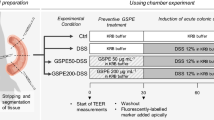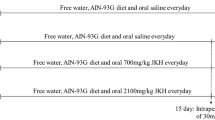Abstract
Objective
Polyethylene glycol (PEG) has been suggested to protect against pathogen colonization by improving colonic barrier function. We aimed to establish whether PEG 4000 affects colonic barrier function and the development of colitis induced by 2,4,6-trinitrobenzenesulfonic acid (TNBS) in rats.
Materials and methods
PEG was included in the drinking water for a period of 48 h before intracolonic administration of TNBS.
Results and discussion
PEG increased colonic surface hydrophobicity and diminished luminal bacterial load. Moreover, PEG markedly reduced mucosal damage and inflammation induced by TNBS. This protection effect appeared to be independent of its laxative properties since the laxatives mannitol or senna extracts had no effect on TNBS colitis. Using everted colonic sacs, pretreatment with PEG produced a lasting reduction in epithelial permeability to mannitol and dextran-70 K that correlated with decreased surface hydrophobicity.
Conclusion
Our results suggest that the protective effect of PEG on TNBS colitis is associated with reinforcement of the epithelial barrier.





Similar content being viewed by others
Abbreviations
- PEG:
-
group of rats treated with polyethylene glycol 4000
- MANN:
-
group of rats treated with mannitol
- SENN:
-
group of rats treated with senna extracts A and B
- TNBS:
-
2,4,6-trinitrobenzenesulfonic acid
- LTB4 :
-
leukotriene B4
- KB:
-
krebs buffer
References
Gardiner KR, Anderson NH, Rowlands BJ, Barbul A (1995) Colitis and colonic mucosal barrier dysfunction. Gut 37:530–535
McCole DF, Barrett KE (2003) Epithelial transport and gut barrier function in colitis. Curr Opin Gastroenterol 19:578–582
Katz KD, Hollander D, Vadheim CM, McElree C, Delahunty T, Dadufalza VD, Krugliak P, Rotter JI (1989) Intestinal permeability in patients with Crohn’s disease and their healthy relatives. Gastroenterology 97:927–931
Schmitz H, Barmeyer C, Gitter AH, Wullstein F, Bentzel CJ, Fromm M, Riecken EO, Schulzke JD (2000) Epithelial barrier and transport function of the colon in ulcerative colitis. Ann N Y Acad Sci 915:312–326
Lugea A, Salas A, Casalot J, Guarner F, Malagelada JR (2000) Surface hydrophobicity of the rat colonic mucosa is a defensive barrier against macromolecules and toxins. Gut 46:515–521
Tatsumi Y, Lichtenberger LM (1996) Molecular association of trinitrobenzenesulfonic acid and surface phospholipids in the development of colitis in rats. Gastroenterology 110:780–789
Schmitz H, Barmeyer C, Fromm M, Runkel N, Foss HD, Bentzel CJ, Riecken EO, Schulzke JD (1999) Altered tight junction structure contributes to the impaired epithelial barrier function in ulcerative colitis. Gastroenterology 116:301–309
Abreu MT, Palladino AA, Arnold ET, Kwon RS, McRoberts JA (2000) Modulation of barrier function during Fas-mediated apoptosis in human intestinal epithelial cells. Gastroenterology 119:1524–1536
Fasano A, Nataro JP (2004) Intestinal epithelial tight junctions as targets for enteric bacteria-derived toxins. Adv Drug Deliv Rev 56:795–807
Rask-Madsen J (1973) The relationship between sodium fluxes and electrical potentials across the normal and inflamed human rectal wall in vivo. Acta Med Scand 194:311–317
Farhadi A, Banan A, Fields J, Keshavarzian A (2003) Intestinal barrier: an interface between health and disease. J Gastroenterol Hepatol 18:479–497
Lugea A, Mourelle M, Domingo A, Salas A, Guarner F, Malagelada JR (2001) Epidermal growth factor increases surface hydrophobicity and resistance to acid in the rat duodenum. Am J Physiol Gastrointest Liver Physiol 280:G774–G779
Goddard PJ, Lichtenberger LM (1995) In vitro recovery of canine gastric mucosal surface hydrophobicity and potential difference after aspirin damage. Dig Dis Sci 40:1357–1359
Lichtenberger LM (1995) The hydrophobic barrier properties of gastrointestinal mucus. Annu Rev Physiol 57:565–583
Lugea A, Antolin M, Mourelle M, Guarner F, Malagelada JR (1997) Deranged hydrophobic barrier of the rat gastroduodenal mucosa after parenteral nonsteroidal anti-inflammatory drugs. Gastroenterology 112:1931–1939
Lugea A, Armengol M, Lara F, Sanchez JL, Malagelada JR, Guarner F. (1998) Surface hydrophobicity of the human colonic mucosa: role of epidermal growth factor (abstract). Gastroenterology 114:150
Matsuo K, Ota H, Akamatsu T, Sugiyama A, Katsuyama T (1997) Histochemistry of the surface mucous gel layer of the human colon. Gut 40:782–789
Podolsky DK, Isselbacher KJ (1983) Composition of human colonic mucin. Selective alteration in inflammatory bowel disease. J Clin Invest 72:142–153
Mattar AF, Teitelbaum DH, Drongowski RA, Yongyi F, Harmon CM, Coran AG (2002) Probiotics up-regulate MUC-2 mucin gene expression in a Caco-2 cell-culture model. Pediatr Surg Int 18:586–590
Roy HK, Gulizia J, DiBaise JK, Karolski WJ, Ansari S, Madugula M, Hart J, Bissonnette M, Wali RK (2004) Polyethylene glycol inhibits intestinal neoplasia and induces epithelial apoptosis in Apc(min) mice. Cancer Lett 215:35–42
Parnaud G, Tache S, Peiffer G, Corpet DE (2001) Pluronic F68 block polymer, a very potent suppressor of carcinogenesis in the colon of rats and mice. Br J Cancer 84:90–93
Corpet DE, Parnaud G (1999) Polyethylene-glycol, a potent suppressor of azoxymethane-induced colonic aberrant crypt foci in rats. Carcinogenesis 20:915–918
Parnaud G, Tache S, Peiffer G, Corpet DE (1999) Polyethylene-glycol suppresses colon cancer and causes dose-dependent regression of azoxymethane-induced aberrant crypt foci in rats. Cancer Res 59:5143–5147
Wu L, Zaborina O, Zaborin A, Chang EB, Musch M, Holbrook C, Shapiro J, Turner JR, Wu G, Lee KY, Alverdy JC (2004) High-molecular-weight polyethylene glycol prevents lethal sepsis due to intestinal Pseudomonas aeruginosa. Gastroenterology 126:488–498
Bedu-Addo FK, Tang P, Xu Y, Huang L (1996) Effects of polyethyleneglycol chain length and phospholipid acyl chain composition on the interaction of polyethyleneglycol-phospholipid conjugates with phospholipid: implications in liposomal drug delivery. Pharm Res 13:710–717
Edwards K, Johnsson M, Karlsson G, Silvander M (1997) Effect of polyethyleneglycol-phospholipids on aggregate structure in preparations of small unilamellar liposomes. Biophys J 73:258–266
Johnsson M, Edwards K (2003) Liposomes, disks, and spherical micelles: aggregate structure in mixtures of gel phase phosphatidylcholines and poly(ethylene glycol)-phospholipids. Biophys J 85:3839–3847
Tubio G, Nerli B, Pico G (2004) Relationship between the protein surface hydrophobicity and its partitioning behaviour in aqueous two-phase systems of polyethyleneglycol-dextran. J Chromatogr B Analyt Technol Biomed Life Sci 799:293–301
Faure JP, Jayle C, Dutheil D, Eugene M, Zhang K, Goujon JM, Petit-Paris I, Tillement JP, Touchard G, Robert R, Wahl A, Seguin F, Mauco G, Vandewalle A, Hauet T (2004) Evidence for protective roles of polyethylene glycol plus high sodium solution and trimetazidine against consequences of renal medulla ischaemia during cold preservation and reperfusion. Nephrol Dial Transplant 19:1742–1751
Gutierrez-Cabano CA (1995) Intragastric polyethylene glycol-400 protects against ethanol-induced gastric mucosal lesions despite pretreatment with indomethacin or iodoacetamide. Dig Dis Sci 40:2029–2036
Demirogullari B, Poyraz A, Cirak MY, Sonmez K, Ozen IO, Kulah C, Karabulut B, Basaklar AC, Kale N (2004) Effects of hyperosmolar agents—lactulose, lactitol, sodium phosphate and polyethylene glycol—on cecal coliform bacteria during traditional bowel cleansing: an experimental study in rats. Eur Surg Res 36:159–164
Braegger C (2004) Polyethylene glycol 3350 without electrolytes: a new safe, effective, and palatable bowel preparation for colonoscopy in children. J Pediatr Gastroenterol Nutr 39:105–106
Halphen M (2004) Polyethylene glycol for constipation. Aliment Pharmacol Ther 19:1133–1134
Pashankar DS, Uc A, Bishop WP (2004) Polyethylene glycol 3350 without electrolytes: a new safe, effective, and palatable bowel preparation for colonoscopy in children. J Pediatr 144:358–362
Vilaseca J, Salas A, Guarner F, Rodriguez R, Malagelada JR (1990) Participation of thromboxane and other eicosanoid synthesis in the course of experimental inflammatory colitis. Gastroenterology 98:269–277
Barthe L, Woodley JF, Kenworthy S, Houin G (1998) An improved everted gut sac as a simple and accurate technique to measure paracellular transport across the small intestine. Eur J Drug Metab Pharmacokinet 23:313–323
Kato T, Hayashi Y, Inoue K, Yuasa H (2004) Functional characterization of the carrier-mediated transport system for glycerol in everted sacs of the rat small intestine. Biol Pharm Bull 27:1826–1830
Tomei S, Torimoto M, Hayashi Y, Inoue K, Yuasa H, Watanabe J (2003) Kinetic characterization of carrier-mediated transport systems for D-glucose and taurocholate in the everted sacs of the rat colon. Biol Pharm Bull 26:899–901
Santos CA, Jacob JS, Hertzog BA, Freedman BD, Press DL, Harnpicharnchai P, Mathiowitz E (1999) Correlation of two bioadhesion assays: the everted sac technique and the CAHN microbalance. J Control Release 61:113–122
Garcia-Lafuente A, Antolin M, Guarner F, Crespo E, Salas A, Forcada P, Laguarda M, Gavalda J, Baena JA, Vilaseca J, Malagelada JR (1997) Incrimination of anaerobic bacteria in the induction of experimental colitis. Am J Physiol 272:G10–G15
Videla S, Vilaseca J, Guarner F, Salas A, Treserra F, Crespo E, Antolin M, Malagelada JR (1994) Role of intestinal microflora in chronic inflammation and ulceration of the rat colon. Gut 35:1090–1097
Videla S, Garcia-Lafuente A, Antolin M, Vilaseca J, Guarner F, Crespo E, Gonzalez G, Salas A, Malagelada JR (1998) Antitumor necrosis factor therapy in rat chronic granulomatous colitis: critical dose-timing effects on outcome. J Pharmacol Exp Ther 287:854–859
van Gorkom BA, de Vries EG, Karrenbeld A, Kleibeuker JH (1999) Review article: anthranoid laxatives and their potential carcinogenic effects. Aliment Pharmacol Ther 13:443–452
van Gorkom BA, Karrenbeld A, Limburg AJ, Kleibeuker JH (1998) The effect of sennosides on colonic mucosal histology and bowel preparation. Z Gastroenterol 36:13–18
Morris GP, Beck PL, Herridge MS, Depew WT, Szewczuk MR, Wallace JL (1989) Hapten-induced model of chronic inflammation and ulceration in the rat colon. Gastroenterology 96:795–803
Fiocchi C (1998) Inflammatory bowel disease: etiology and pathogenesis. Gastroenterology 115:182–205
Kraehenbuhl JP, Pringault E, Neutra MR (1997) Review article: Intestinal epithelia and barrier functions. Aliment Pharmacol Ther 11 Suppl 3:3–8
Goddard PJ, Kao YC, Lichtenberger LM (1990) Luminal surface hydrophobicity of canine gastric mucosa is dependent on a surface mucous gel. Gastroenterology 98:361–370
Fihn BM, Jodal M (2001) Permeability of the proximal and distal rat colon crypt and surface epithelium to hydrophilic molecules. Pflugers Arch 441:656–662
Tomita M, Menconi MJ, Delude RL, Fink MP (2000) Polarized transport of hydrophilic compounds across rat colonic mucosa from serosa to mucosa is temperature dependent. Gastroenterology 118:535–543
Corpet DE, Parnaud G, Delverdier M, Peiffer G, Tache S (2000) Consistent and fast inhibition of colon carcinogenesis by polyethylene glycol in mice and rats given various carcinogens. Cancer Res 60:3160–3164
Persson D, Thoren PE, Lincoln P, Norden B (2004) Vesicle membrane interactions of penetratin analogues. Biochemistry 43:11045–11055
Erdogan B, Isiksoy S, Dundar E, Pasaoglu O, Bal C (2003) The effects of sodium phosphate and polyethylene glycol-electrolyte bowel preparation solutions on 2,4,6,-trinitrobenzenesulfonic acid-induced colitis in the rat. Exp Toxicol Pathol 55:213–220
Acknowledgments
This work was supported by grants from Instituto de Salud Carlos III (C03/02), Ministerio de Ciencia y Tecnologia (SAF 2003-05262), and Generalitat de Catalunya (RE: 2001SGR00389).
Author information
Authors and Affiliations
Corresponding author
Additional information
Sebastián Videla and Aurelia Lugea contributed equally to this study.
Rights and permissions
About this article
Cite this article
Videla, S., Lugea, A., Vilaseca, J. et al. Polyethylene glycol enhances colonic barrier function and ameliorates experimental colitis in rats. Int J Colorectal Dis 22, 571–580 (2007). https://doi.org/10.1007/s00384-006-0232-4
Accepted:
Published:
Issue Date:
DOI: https://doi.org/10.1007/s00384-006-0232-4




